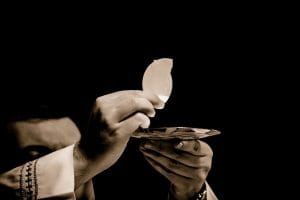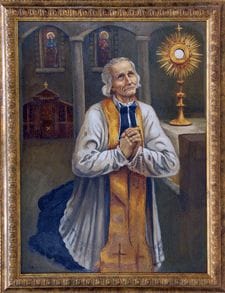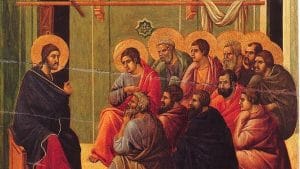As mentioned in a previous post, the Church has long understood Sacramental Grace as operating in two dimensions. On the objective plane we say that the Sacraments contain grace ex opere operato. What this means is that grace is made available by the Sacrament regardless of either the faith of the recipient or the minister. It is created “from the work performed.” This does not mean however that the recipient of the Sacrament is a recipient of grace or even all the grace that is available. That is because there is also a subjective plane by which the grace received is proportional to the disposition of the receiver. In no other Sacrament is this distinction more important than in the Eucharist, not only because It contains grace, but because it contains the Author of Grace Himself. Therefore, there is an abundance of grace available to the receiver provided that he is properly disposed to receive it.
Obviously then, preparation to receive Holy Communion ought to be the primary focus for those who desire closer communion with Christ and through Him the Holy Trinity. But for most of us, our preparation is sorely lacking either through ignorance, neglect, or distraction. Thankfully St. Louis de Montfort has left the Church a surefire way to prepare to receive Holy Communion that is sure to increase the graces we receive.
Our Lady of the Eucharist
To grasp the simplicity of his method we must first remove any abstractions we might have related to Our Blessed Mother. What is meant by this is that we all too often forget that she was a real person who lived out her Christian life in the Early Church. When Our Lord left her in St. John’s care, He wasn’t just taking care of her physical well-being. Nor was He abandoning her to someone else’s care. Instead, He was leaving her in the care of one of the men whom He had empowered to make Him present to her. In other words, Jesus left Mary with St. John so that she could receive Him in the Eucharist daily.
Once we realize that Our Lady received the Eucharist regularly, we can begin to let our imagination take to flight as to what her disposition was like when she received Him. Her heart was found worthy for her womb to house the Son of God would have daily received Him into that same Immaculate Heart with a renewed and deeper love than at the Incarnation. Her fiat would have echoed in her Amen. Separated from His physical presence, she would have run to the Communion rail to taste that presence once again. She would have offered herself yet again as the Sorrowful Mother at the foot of the Cross and renewed her commitment to be Mother of all the Elect just prior to receiving. She would have overflowed with adoration and thanksgiving after her reception. She would have longed to receive Him again when she wasn’t at Mass. The love with which she received Him grew so much that upon receiving her Viaticum she was taken body and soul to Heaven. She was and is always Our Lady of the Eucharist.
St. Louis de Montfort, Our Lady, and Holy Communion
Knowing that Our Lady’s disposition was perfect for receiving Our Lord in the Eucharist may inspire us to imitate her example, but that is not the reason why this reflection is necessary. When Our Lord is received by one of her children, she flies to that child in order to adore His Eucharist presence. As she draws closer to Jesus within the bosom of the believer, Jesus only draws closer to the believer. Her act of adoration brings more glory to God than all earthly acts of adoration and He pours His pleasure of being in her presence out on this child of His Mother.

All of this may go on without our awareness or we might, following the advice of St. Louis de Montfort, actively and consciously participate in it. The Saint says in The Secret of Mary that the best way to prepare for Holy Communion is to “implore that good Mother to lend you her heart, that you may receive her Son there with the same dispositions as her own.” We pledge that if she will give us her heart, then we will place Jesus in it. For those fortunate souls that who are consecrated to Jesus through Mary, the two of them during Holy Communion will lodge within our soul. Our Lady will share with Our Lord all our needs and will glorify Him more than in our asking. As St. Louis de Montfort puts it, “Let us allow the King and Queen to speak together. Let us not disturb their divine colloquies by our restless thoughts and unsettled desires. Let us entrust to them the care of our future and the choice of means.”

















